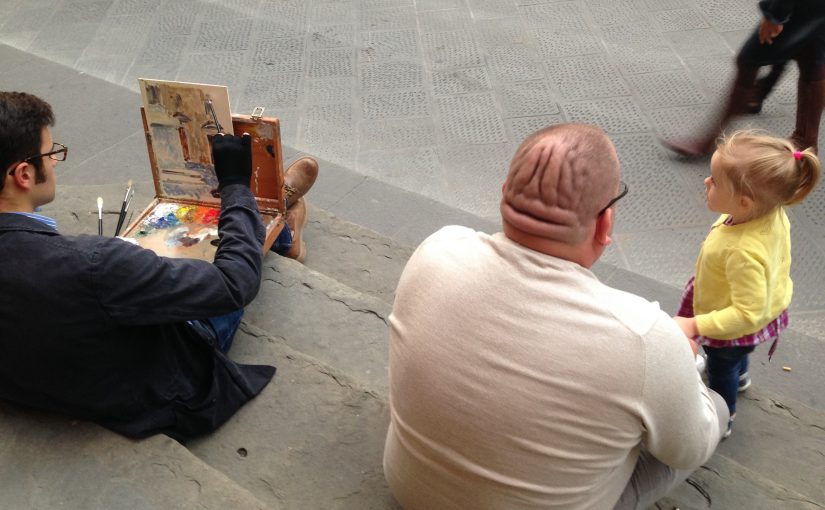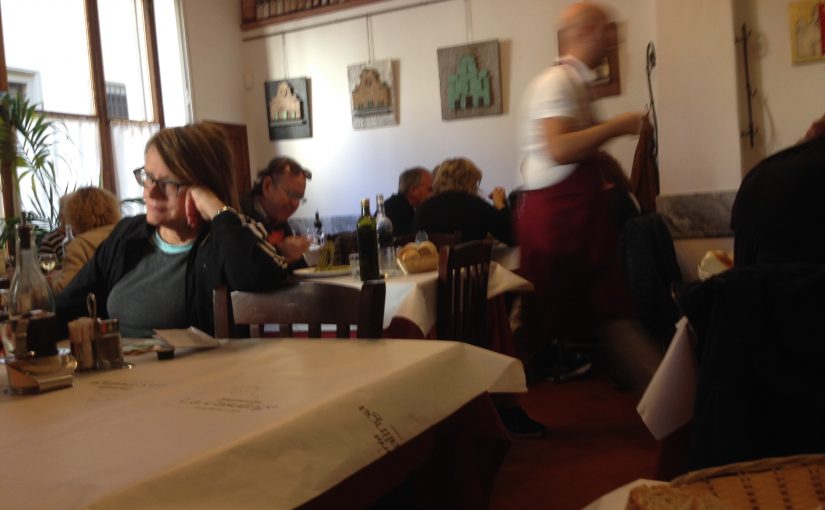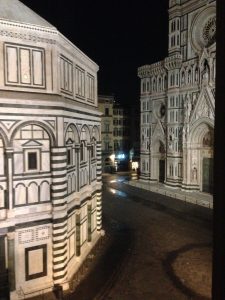Yesterday afternoon after lunch at Casalinga and the walk up to San Miniato, I had three hours before my bus to La Romola and two hours before there was any reason to pick up my pack at the pensione. I needed a place to sit, so I walked to Piazza della Santa Trinita where stands a large, official-looking, Renaissance structure with built-in benches on all sides, and found a comfortable spot by the front door where the frame juts out to afford a place to lean. In the piazza, is a monumental column surmounted by a statue holding a scale and a sword, perhaps an Italian representation of Justice. If so, Justice here is not blind.
At the base of the column, a fellow played a pleasant, if rather lame, accordion for coins in the hat. The piazza is always filled with people walking in all directions, carriages, women on bicycles, the occasional young man on roller blades, the errant automobile or scooter, children, and dogs. They were out in droves, no order, no lanes, crisscrossing at will. To these American eyes it looked treacherous, but everyone simply paid attention. I watched for a happy quarter of an hour.
Then a round fellow – who wore a thick gold necklace resembling a Celtic torque, but was otherwise attired in the international uniform of blue jeans and pullover – began to negotiate with the accordionist. With him was a slender young man with the most immaculately trimmed sideburns I have ever seen. He was carrying a small wooden case, his larger friend, a guitar. The slender one sat down immediately to my right. In the moment of his arrival, a marvelous looking woman close to my age rode up on her bicycle and stopped to discuss something with him. She was layered in skirts and shawls and jewelry, all in shades of brown and tan, and sported a broad-brimmed felt hat. Many of the ladies in Firenze who ride bicycles are similarly dressed. I don’t know how it is that their skirts do not continually catch in the bicycle’s chain, but they don’t. They lend a wondrous quality to the ongoing parade.
The young man with guitar put up a music stand, (the accordionist had closed shop) tuned, and strummed a few introductory chords. His strumming provided background to my people watching, but when he began to sing I was startled into focussing again on him. He had a voice so sweet, and at the same time, so penetrating, that my first instinct was to search out a microphone. There was none. Yet, even when his back was turned his voice was clear and bell-like. Everyone in the piazza began to tap and sway, or to walk in time to his music. At the end of the first song, the young man to my right clapped a muffled clap; he wore knit gloves with the finger tips cut out. I joined him. Thereafter, each song received generous applause and the guitar case gradually filled with coins.
Three or four songs later, the young man with the sideburns opened his wooden box. It was an artist’s kit, palette already smeared with color. He fiddled for awhile, closed it again, and observed. A few minutes more, he moved immediately to my left, reopened the box, set up a piece of canvas board, and began to sketch the scene before him with diluted paint. His moves with the brush were easy, free, and relaxed, flicking and spreading thinned color as he massed out the scene. A young woman in front of me moved behind him to take a photo. Nothing affected his concentration.
A large man with his head shaved to reveal a scalp as wrinkled as the face of one of those Chinese dogs – the name of which I forget – sat just below and between us. With him was the most remarkable little girl. Over her blue jeans, she wore a red plaid dress and a bright yellow sweater buttoned at the top. She sat and moved and observed with easy authority, touching her father gently on the arm or leg as if to provide comfort. While he seemed a good dad, at that moment he also seemed oblivious to what a special child accompanied him. Along with the young woman and a dozen or so others, the little girl quickly developed an avid interest in the artist to my left. Her dad warned her not to disturb with a single, mumbled, “no.” She returned to the step next to him for about thirty seconds, then was up again to admire the artist as he coaxed his picture to life. His concentration never wavered. I think she knew it wouldn’t. There is something of the same concentration already alive in her.
The singer drew confidence from the swaying and tapping and applause, and stepped further into the piazza, giving his performance more dance and strut. Carriages passed, bicycles, strollers with babies, dogs straining at their leashes, the young, the old, the quick, the slow; all moved more easily, and more happily, as a result of his song.
Then, as if spit out from Dante’s Inferno, arrived a Schmidt; the little street sweepers used here that are identified by that lonely name printed in bold, black letters on a large field of white. It circled the monument, roaring its righteous call to purity like a modern Savonarola. The positions of the crowds would not let it sweep where the litter lay – and thus it must always be except for late at night or early in the day – but that did not convince it to move on and let us have our music. It continued to circle, went up the street a way, turned, and looped; back and forth, back and forth. Our singer surrendered and stowed his guitar. The Schmidt, victorious, moved on down the corso.
“Can’t compete with the sanitation department,” the singer said. He was American. I went over to his case, and dropping a two euro coin, gave him a thumbs up. He thanked me with grazie, I offered prego in return. He checked out his friend’s painting, now beginning to show depth and detail, and voiced his approval. I wanted to tell him how lovely his voice is, but couldn’t decide what language to use – as if it mattered. Or as if an imaginary language barrier were my shield and protection.


